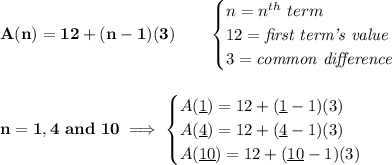
Mathematics, 16.11.2019 15:31 shay8850
Find the first, fourth, and tenth terms of the arithmetic sequence described by the given rule.
a(n) = 12 + (n – 1)(3)
a.12, 21, 39b. 0, 9, 27c. 12, 24, 42d. 3, 24, 27

Answers: 2


Other questions on the subject: Mathematics

Mathematics, 21.06.2019 19:00, heartykwarteng12
The reflexive property of congruence lets you say that ∠pqr ≅
Answers: 1

Mathematics, 21.06.2019 19:50, adjjones2011
The probability that an adult possesses a credit card is .70. a researcher selects two adults at random. by assuming the independence, the probability that the first adult possesses a credit card and the second adult does not possess a credit card is:
Answers: 3

Mathematics, 21.06.2019 21:30, sandersmakaylaovq5vu
Rhombus adef is inscribed into a triangle abc so that they share angle a and the vertex e lies on the side bc . what is the length of the side of the rhombus if ab=c, and ac=b.
Answers: 1
You know the right answer?
Find the first, fourth, and tenth terms of the arithmetic sequence described by the given rule.
Questions in other subjects:


English, 17.10.2019 04:30



Medicine, 17.10.2019 04:30



Chemistry, 17.10.2019 04:30






